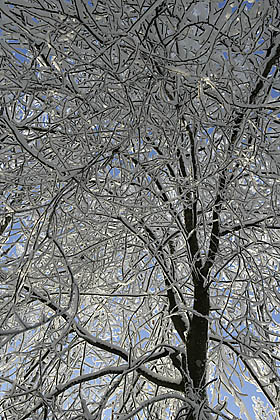Tree of the year - bird cherry
Photo: Arne Ader
Translation: Liis
Snow on bird cherry tree.
| Bird cherry |
Harilik toomingas
|
Padus avium; Prunus padus |
Our TREE OF THE YEAR for this year grows in rather humid locations, in broadleaf and mixed forests; it is a common species of thickets at river banks. As a young tree it tolerates shade, later needs light. It prefers rather fertile soil and is frost-hardy. It easily produces new growth from stubs and roots, and belongs to the soil-improving species.
The mightiest of Estonian bird cherries reach a height of more than 15 meters and have trunk circumferences of more than a meter.
How to know a bird cherry in winter? When in doubt: if a piece of bird cherry bark is rubbed between the fingers it gives off a characteristic smell of bird cherry.
We will keep an eye on the tree of the year!
Trees of the year up to now have been juniper (kadakas; 1996), spruce (kuusk; 1997), oak (tamm; 1998), birch (kask; 1999), rowan (pihlakas; 2000), pine (mänd; 2001), lime (pärn; 2002), maple (vaher; 2003), alder (lepp; 2004), aspen (haab; 2005), willow (paju; 2006), ash (saar; 2007), yew (jugapuu, 2008) and hazel (sarapuu; 2009
How to know a bird cherry in winter? When in doubt: if a piece of bird cherry bark is rubbed between the fingers it gives off a characteristic smell of bird cherry.
We will keep an eye on the tree of the year!
Trees of the year up to now have been juniper (kadakas; 1996), spruce (kuusk; 1997), oak (tamm; 1998), birch (kask; 1999), rowan (pihlakas; 2000), pine (mänd; 2001), lime (pärn; 2002), maple (vaher; 2003), alder (lepp; 2004), aspen (haab; 2005), willow (paju; 2006), ash (saar; 2007), yew (jugapuu, 2008) and hazel (sarapuu; 2009
Professor Viktor Masing initiated the nomination of a tree of the year, following a Finnish idea.
The tree of the year is selected by the editorial board of the journal Eesti Loodus.









